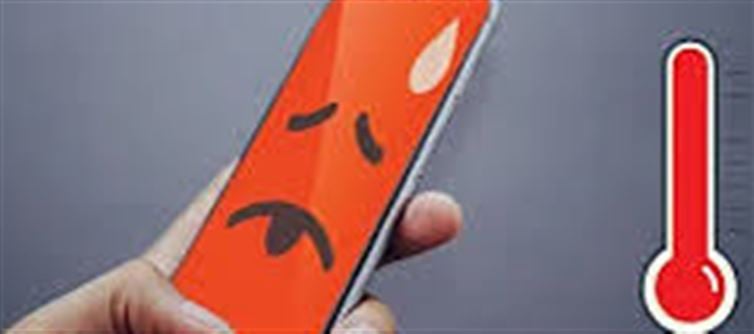
Smartphones have become an integral part of our daily routines—whether it's for work, communication, or entertainment. However, like any device, smartphones can face some technical issues, and one common problem that many users encounter is overheating. When a phone gets too hot, it can affect the device's performance, damage its internal components, and in extreme cases, it could even cause a fire or explosion.
If your phone is heating up frequently, it's crucial to address the issue before it causes permanent damage. Here are four simple fixes to cool down your device and ensure its safety.
1. Close Unnecessary Apps and Processes
One of the most common reasons your phone gets hot is that too many apps are running simultaneously, consuming a significant amount of processing power. This constant demand can overwork your phone’s CPU, leading to overheating.
How to fix it:
· Close unused apps: Double-check your phone’s multitasking view and swipe away apps that you’re not currently using.
· Disable background processes: Some apps run in the background even when you're not using them, which can cause the phone to overheat. Go into your phone's Settings > Battery > Battery Usage to identify and close such apps.
· Force-stop apps: If you notice any app consuming too much CPU or battery, force-stop it through the settings.
2. Remove the phone Case
While phone cases help protect your device, they can also trap heat, especially if the case is thick or made from non-breathable materials like plastic. This can prevent the phone from cooling down properly.
How to fix it:
· Remove the case temporarily: If your phone is overheating, take off the case and let your device cool down naturally. This will help the phone’s internal components to release heat.
· Opt for breathable materials: If you need a case, choose one made from silicone or fabric that allows air circulation, which helps in reducing heat buildup.
3. Check for software Updates
Outdated software or bugs in the system can cause your phone to overheat. Manufacturers often release updates to fix such issues, improve performance, and optimize power consumption.
How to fix it:
· Update your phone’s software: Go to Settings > Software Update (or About Phone) and check if there’s any new update available. Updating your operating system and apps ensures that bugs, which could cause overheating, are resolved.
· Clear app caches: Some apps may accumulate cache files over time, which could cause the phone to run inefficiently. In Settings, go to Storage and clear cache for apps that use excessive storage.
4. Avoid Direct Sunlight and Overcharging
Prolonged exposure to direct sunlight or charging your phone overnight can lead to overheating. When your phone is exposed to sunlight or heat sources, the battery temperature rises, increasing the risk of damage. Additionally, overcharging—leaving your phone plugged in once it hits 100%—can cause it to stay at a high temperature for too long.
How to fix it:
· Keep your phone out of the sun: Avoid leaving your phone in hot environments, such as in the sun or on heated surfaces (like a car dashboard).
· Don’t overcharge: Unplug the phone once it's fully charged, or use a smart charger that stops charging once the battery reaches 100%. If you need to charge overnight, consider charging it before bed and unplugging it as soon as it reaches full charge.
Bonus Tips for Preventing Overheating:
· Turn on power-saving mode: Most smartphones offer a battery saver mode that reduces power-hungry functions, helping the phone cool down.
· Lower screen brightness: A brighter screen can put additional stress on the phone’s processor and cause it to heat up. Lowering the brightness can help keep the phone cooler.
· Switch to airplane mode: If your phone gets too hot during an incoming call or while browsing the web, try switching to airplane mode temporarily to reduce network-related stress on the device.
· Remove unnecessary widgets: Widgets on your home screen may require constant updates and can use up resources. Remove any that are not essential.
When to Seek Professional Help
While these tips can often help manage overheating, if your phone continues to overheat even after following these steps, it might indicate a deeper issue, such as:
· Faulty battery: An old or damaged battery can be the primary cause of excessive heat. In such cases, it’s best to visit a service center to get the battery replaced.
· Hardware damage: If the internal components are overheating, you may need to get your phone checked by a professional technician.
· Malware or software issues: Persistent overheating could also be a result of malware or other software issues that are draining system resources.
Conclusion
Smartphone overheating is a serious issue that shouldn’t be ignored, as it can lead to long-term damage to your phone’s battery and internal components. By following the simple fixes above, you can ensure that your phone stays cool and runs efficiently. If the overheating problem persists, don't hesitate to consult a technician or visit your phone’s service center. Always remember that taking preventive measures is the best way to keep your phone in top condition and avoid any potential safety risks, including fire hazards.
Disclaimer:
The views and opinions expressed in this article are those of the author and do not necessarily reflect the official policy or position of any agency, organization, employer, or company. All information provided is for general informational purposes only. While every effort has been made to ensure accuracy, we make no representations or warranties of any kind, express or implied, about the completeness, reliability, or suitability of the information contained herein. Readers are advised to verify facts and seek professional advice where necessary. Any reliance placed on such information is strictly at the reader’s own risk..jpg)




 click and follow Indiaherald WhatsApp channel
click and follow Indiaherald WhatsApp channel